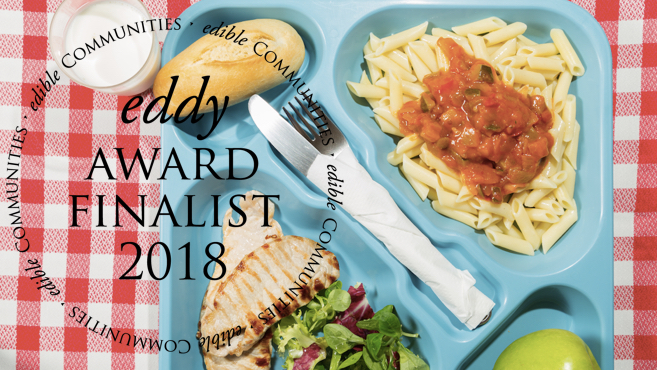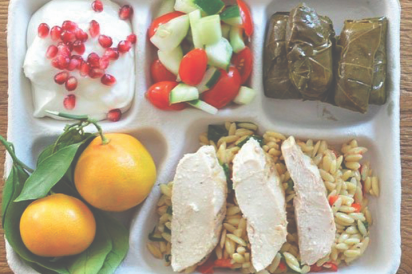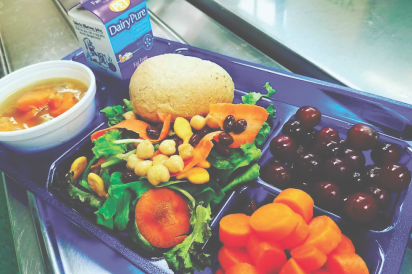The School Lunch Tray
 2018 Eddy Award Finalist for Best Social Issue Story
2018 Eddy Award Finalist for Best Social Issue Story
The American school lunch … it’s been riddled with stigma since inception. Does anyone else remember the chili on Monday that became the hot dog topping on Tuesday and then the nacho condiment on Wednesday? How about the mixed vegetables that were clearly mechanically forged into perfect squares, the slimy canned pears that came in two halves or the pizza crust that was reminiscent of cardboard with cheese that seemed to melt in one sheet? Chances are, if you went to school in the U.S., you remember, like I do, those less-than-palatable lunches. And now, not only do many school lunches taste and look bad, most of it isn’t good for you, either.
“You are what you eat.” – Anthelme Brillat-Savarin
So what’s a country to do? Nutrition standards for school meals are set by the National School Lunch and Breakfast Program (NSLP). Established by the USDA, and signed into effect by President Truman, the program went through a major facelift, including many substantive changes, in 2012. The essence of the changes came down to this (the rule is almost 80 pages and received almost 65,000 public comments before it was published so I’ve cut to the chase):
This rule requires most schools to increase the availability of fruits, vegetables, whole grains and fat-free and low-fat fluid milk in school meals; reduce the levels of sodium, saturated fat and trans fat in meals; and meet the nutrition needs of school children within their calorie requirements. These improvements to the school meal programs, largely based on recommendations made by the Institute of Medicine of the National Academies, are expected to enhance the diet and health of school children, and help mitigate the childhood obesity trend.
The changes were motivated by programs like First Lady Michelle Obama’s “Let’s Move” campaign and the Healthy Hunger-Free Kids Act (HHFKA), both in 2010, which were established to promote good eating habits early in life and to fight our nation’s childhood obesity problem—according to the American Heart Association, between 1971 and 2011 childhood obesity prevalence tripled. But while we all appreciate the need for change, change never comes easy.
Under the rules, states maintain control about what specific foods to serve, so they can create their own menus and can determine, for the most part, how to serve those items … as long as they follow rule requirements. There are resources available to schools on how to meet these requirements via webinars and conferences and info at ChooseMyPlate.org, but the ubiquitous struggle to deliver it all within cost parameters while still meeting nutritious requirements is tough.
What’s in a menu
Meals have to be exciting, but they also have to taste good while adhering NSLP standards, including daily and weekly minimum requirements for fruits, vegetables, grains, meat or meat alternate and milk, as well as weekly minimum requirements for dark green veggies, red-orange veggies, legumes and starches. Additionally, there are calorie, fat and sodium limits. (Mind you, some of the requirements will take time to come into effect—like sodium reduction, which has a timeframe extending all the way out until 2023 before the needed reductions are fully made.)
Like most federal programs, if you want federal dollars you need to follow requirements. And schools in the Hoosier State—like the other 49 states—want and need those dollars. The Indiana Department of Education’s Division of School and Community Nutrition Programs is in charge of following the NSLP. But helping schools around the state follow the requirements, and schools actually being able to do so, isn’t easy.
“It is an incredible challenge to come up with healthy food items that meet my standard as a registered dietitian, meet the requirements the government has set and gets the kids’ approval,” says Elizabeth Edwards, school nutrition director for a consortium of five pre-K through eighth-grade schools in Indianapolis. But, admits Edwards, her standards are different than many others working in her same role for neighboring districts.
“I know several other RDs (registered dietitians) working as directors who do not have the desire to change and or see the need for change or reform to the school food programs.” Edwards points to the amount of sugar kids are served in a typical school breakfast and says she can’t comprehend how any RD can be OK with it. “A grain-based sugar-added entrée, side of fruit or raisins, an OJ and chocolate milk is a despicable amount of sugar,” she said, adding that it’s not her intent to blast other RDs directly or indirectly, but rather to set a high standard herself and lead by example. Of course finding healthier alternatives kids will eat isn’t an easy task.
“It’s probably no surprise,” she says, “that fresh, raw vegetables are a tough sell, but so are most dishes that aren’t a hot dog, pizza or nachos. I’ve had many recipes I thought would be a hit that ended up being flops.” Along with the issue of taste, Edwards and her fellow RDs face massive budgetary restraints.
“Many new recipes fail when I cost them out,” she says. “We have very limited funding. Last school year, for each student qualifying for free meals, we received $3.22 in reimbursement per lunch, $2.04 per breakfast and $0.86 per snack.” And those amounts, she says, are all the maximum reimbursement allowed. “This reimbursement is the only income we receive—school nutrition programs are almost always separate from the school [budget] and operate on their own.”
To make it even tougher, some schools aren’t even getting the funds they deserve. In October 2015, the School Nutrition Association in conjunction with the School Superintendents Association penned a letter to Congress stating “school districts do not receive the full reimbursement from the USDA for the increased costs associated with the new meal standards.” (The requirements added $0.10 to the cost of lunch and $0.27 cents to breakfast, but schools reported only receiving $0.06 per lunch and nothing for breakfast.)
And the challenges for states and schools isn’t the only issue—what about the students?
Life after new rules
The website DoSomething.org asked American students to upload their lunch photo, name it and answer a survey about what they thought of the meal quality. They could vote on their lunch with “eat it” or “toss it,” and they could also vote on others’ submitted lunch photos in the same way. Out of this useful social experiment—these are the people who actually eat school lunches, after all—a report was compiled. You can, and you should, go to the website and read it, but the most important facts are these: 70 percent of all school meals were determined to be “trashworthy by users” and 57 percent of what students considered nutritious meals were voted as “eat it.” And to be fair, rule changes were still being rolled out as the 576,846 votes were being cast, and not everything students had to say was bad. There was someone who called their lunch “the heaven bowl,” but in the end it’s hard to see past the posts or indiscernible eats with titles like “road kill patty” and “pork slop.” (What about the “pizza puck”? … that’s what one of my friends called it in high school.)
Another obvious problem facing states and schools, including menu planners like Edwards, isn’t just the cost of school lunches, it’s food waste. Under the new rules, the goal is to offer kids more nutritious foods, not just serve them. Schools call it “Offer versus Serve (OVS),” with the idea of keeping waste down. Yes, the school lunches provided today are healthier than the ones provided 10 years ago, but just because they’re healthier doesn’t mean they’re being eaten. A study by the Harvard School of Public Health estimates since the induction of the HHFKA, roughly 56 percent more food is being thrown away. And some blame the new requirements for creating what they call unpalatable lunches (remember that pork slop?).
In April of this year, Agriculture Secretary Sonny Perdue signed a proclamation to do away with the “healthy federal school lunch standards set in place by the Obama administration.”
“This announcement,” said Perdue, “is the result of years of feedback from students, schools and food service experts about the challenges they are facing in meeting the final regulations for school meals … if kids aren’t eating it then it’s defeating the purpose.” In a follow up, the Agriculture Department released a statement declaring its desire to restore local control of guidelines on whole grain, sodium and milk.
Rome wasn’t built in a day and neither was the school lunch
While school lunches still don’t meet the nutritional standards nearly most of us wish they would, there are organizations that care and are doing their part to improve the school lunch scene as well as the food mindset of children. I’ve written about the Patachou Foundation, which focuses on feeding food insecure children wholesome meals and creating healthy habits. And in this issue you’ll read about Earthonauts, a program dedicated to teaching at-risk youth the importance of good food. And we’ve included an entire section on food grants available to schools. Also, there are many school gardens throughout the state, which you may be lucky enough to see on your drive to work or at your child’s school, and The Indiana and National Farm to School Networks are there to help with toolkits about local food sourcing in schools, which can be found on their websites. The School Nutrition Association, a nonprofit dedicated to “advancing the quality of school meal programs through education and advocacy,” is also trying to do its part. These are just a few organizations that want kids to eat good food.
If I could sit down with Harry Truman right now, I wonder what he would say about where the school lunch program has been and where it’s going. Some questions that come to mind: Should the federal government define school lunches? Should schools take more responsibility in teaching our youth how to eat properly? Should school meals adhere to strict nutritional guidelines? And what are those guidelines? The questions are endless, but bottom line, while well-meaning parents, educators, nutritionists and even politicians can and do fall on both sides of the school lunch debate, we all need to come together and ultimately decide what’s best for our children is good, healthy food, and somehow, someway we need to make sure they’re getting it.
Call to Action! How can you change school lunches?
- Find your legislator at IGA.IN.Gov and then share your thoughts with them
- Get involved with a local foundation that cares what our kids eats, like the Patachou Foundation or Edible Indy Foundation
- Learn more about the National Farm to School Network at FarmtoSchool.org











